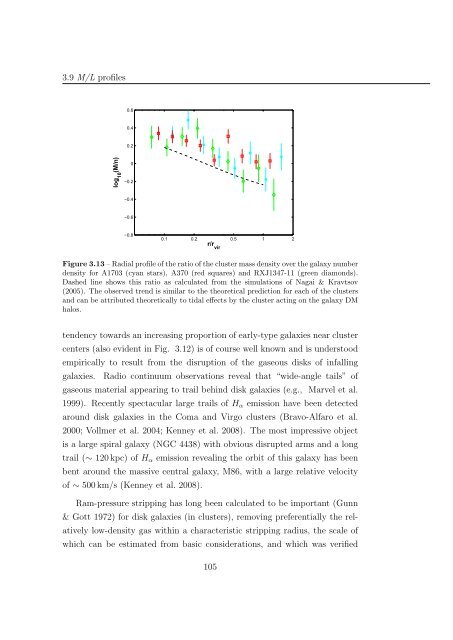Mass and Light distributions in Clusters of Galaxies - Henry A ...
Mass and Light distributions in Clusters of Galaxies - Henry A ...
Mass and Light distributions in Clusters of Galaxies - Henry A ...
You also want an ePaper? Increase the reach of your titles
YUMPU automatically turns print PDFs into web optimized ePapers that Google loves.
3.9 M/L pr<strong>of</strong>iles<br />
0.6<br />
0.4<br />
0.2<br />
log 10<br />
(M/n)<br />
0<br />
−0.2<br />
−0.4<br />
−0.6<br />
−0.8<br />
0.1 0.2 0.5 1 2<br />
r/r vir<br />
Figure 3.13 – Radial pr<strong>of</strong>ile <strong>of</strong> the ratio <strong>of</strong> the cluster mass density over the galaxy number<br />
density for A1703 (cyan stars), A370 (red squares) <strong>and</strong> RXJ1347-11 (green diamonds).<br />
Dashed l<strong>in</strong>e shows this ratio as calculated from the simulations <strong>of</strong> Nagai & Kravtsov<br />
(2005). The observed trend is similar to the theoretical prediction for each <strong>of</strong> the clusters<br />
<strong>and</strong> can be attributed theoretically to tidal effects by the cluster act<strong>in</strong>g on the galaxy DM<br />
halos.<br />
tendency towards an <strong>in</strong>creas<strong>in</strong>g proportion <strong>of</strong> early-type galaxies near cluster<br />
centers (also evident <strong>in</strong> Fig. 3.12) is <strong>of</strong> course well known <strong>and</strong> is understood<br />
empirically to result from the disruption <strong>of</strong> the gaseous disks <strong>of</strong> <strong>in</strong>fall<strong>in</strong>g<br />
galaxies. Radio cont<strong>in</strong>uum observations reveal that “wide-angle tails” <strong>of</strong><br />
gaseous material appear<strong>in</strong>g to trail beh<strong>in</strong>d disk galaxies (e.g., Marvel et al.<br />
1999). Recently spectacular large trails <strong>of</strong> H α emission have been detected<br />
around disk galaxies <strong>in</strong> the Coma <strong>and</strong> Virgo clusters (Bravo-Alfaro et al.<br />
2000; Vollmer et al. 2004; Kenney et al. 2008). The most impressive object<br />
is a large spiral galaxy (NGC 4438) with obvious disrupted arms <strong>and</strong> a long<br />
trail (∼ 120 kpc) <strong>of</strong> H α emission reveal<strong>in</strong>g the orbit <strong>of</strong> this galaxy has been<br />
bent around the massive central galaxy, M86, with a large relative velocity<br />
<strong>of</strong> ∼ 500 km/s (Kenney et al. 2008).<br />
Ram-pressure stripp<strong>in</strong>g has long been calculated to be important (Gunn<br />
& Gott 1972) for disk galaxies (<strong>in</strong> clusters), remov<strong>in</strong>g preferentially the relatively<br />
low-density gas with<strong>in</strong> a characteristic stripp<strong>in</strong>g radius, the scale <strong>of</strong><br />
which can be estimated from basic considerations, <strong>and</strong> which was verified<br />
105
















